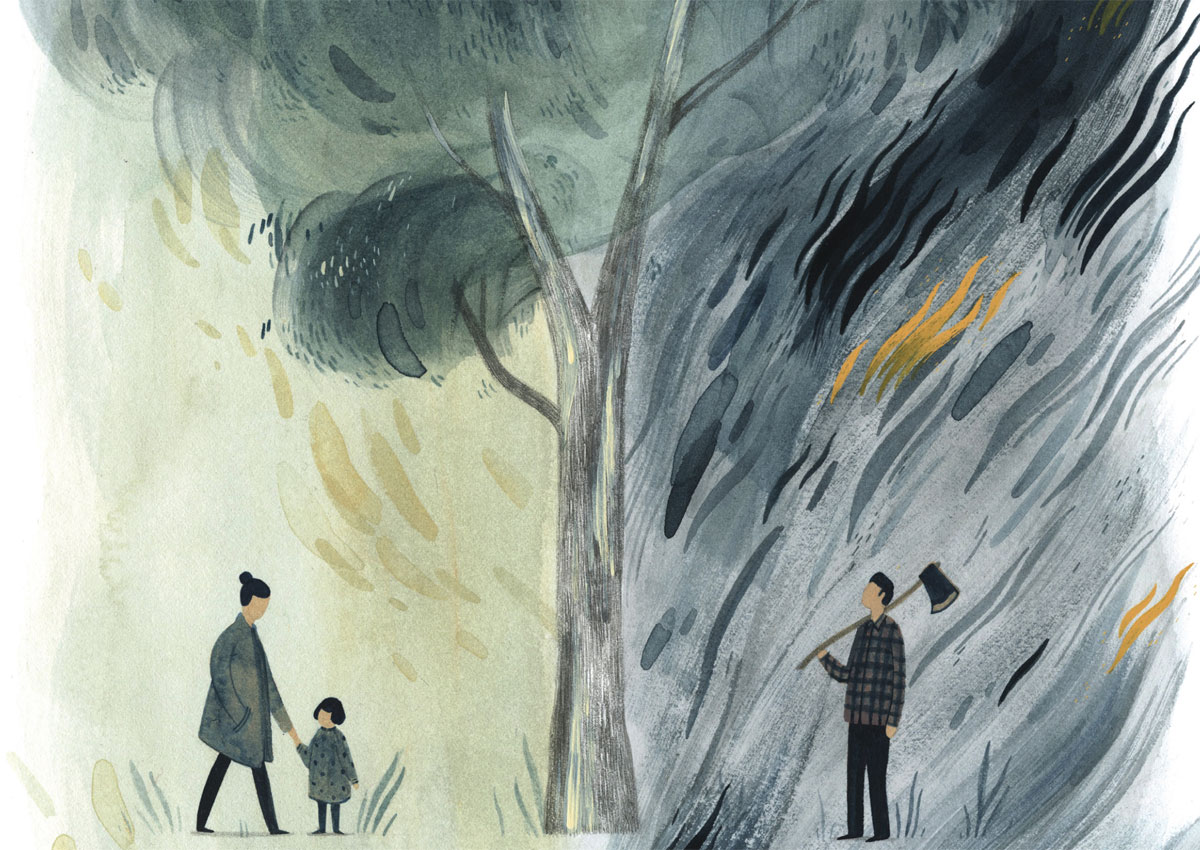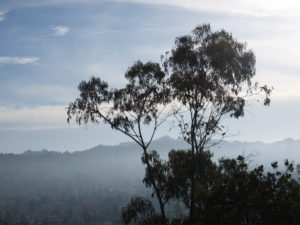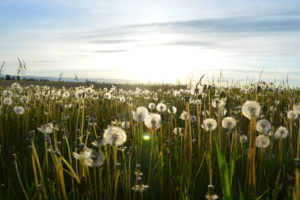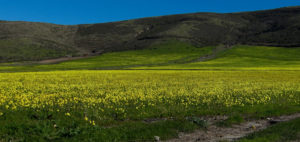The gums are mottled tan and brown like chicken bones, crowded together, the spaces between them choked with brush and hung with streamers of bark. Along with the sweet medicine smell of the trees, there is the warm scent of sawdust and a sour hint of exhaust. I’m with Brad Gallup, a fire captain with the East Bay Regional Park District. We’re deep in Tilden Regional Park, standing on a fire road between a feller buncher and a chipper. It’s his job to make sure that if and when this forest burns, it doesn’t take half of Berkeley with it.
In front of us on the uphill side of the road is what looks like a group of seven trees but is really a single tree with multiple boles. Like many of the trees in this forest, it was cut after the hard frost of 1972. Tasmanian blue gums, Eucalyptus globulus, don’t like cold. But the frost didn’t really kill the trees, only made them retreat back down into their roots. The workers who cut the trees then didn’t treat the stumps with herbicide, and now they’re regrown, more trunks and closer together.
The ground below this tree is littered with its rooster-tail leaves and cinnamon-stick tubes of bark. More bark peels from the trunks and spills out from piles built up in the valleys between them. Gallup considers the gum, buried in a pyre of its own debris. “That’s a great way to get the tree to burn,” he says. “Like, you couldn’t come up with a better way to get that tree to burn.” This tree is surrounded by others just like it; this grove just one of the dozens between here and Lake Chabot, millions of blue gums billowing from the ridgeline like sage-green smoke.
The 1991 Tunnel Fire in the Oakland Hills, which killed 25 people and destroyed more than 3,000 homes, confirmed for many people what they had long suspected: Eucalypts are a hazard. Though the fire started in grass, the trees were blamed for the severity of the disaster, by some estimates contributing almost three-quarters of the fire’s energy. Last year, after a decade of planning and legal hurdles, the Federal Emergency Management Agency approved a $5.7 million fire prevention grant to UC Berkeley, the City of Oakland, and the East Bay Regional Park District—the major land managers in the hills area—to thin and remove trees and brush on 1,000 acres of ridgeline between Wildcat Canyon and Anthony Chabot regional parks; the park district will thin another 1,000 acres. Of those 2,000 acres, roughly 800 are dominated by blue gum—representing perhaps a quarter of the East Bay’s eucalyptus. The Hills Conservation Network, a small Berkeley nonprofit whose members live in the area covered by the FEMA grant, promptly sued FEMA to stop the grant, focusing in particular on roughly 350 acres of Oakland and UC Berkeley property in Claremont Canyon and Strawberry Canyon and around the Caldecott Tunnel, where all nonnative trees—predominately eucalyptus—would be removed. It argued that clearing trees would actually make the hills more flammable.
“Every piece of vegetation is flammable. It’s not just eucalyptus we target. We target grass. We target brush.”
-Brad Gallup, EBRPD fire captain
What is ostensibly a debate about fire science is more than that, though—it is really just the latest episode in a decades-old dispute over the Australian trees’ place in the Bay Area. There are plenty of people who simply like the trees for their own sake, but the debate is also about deeper questions, like what it really means for a species to be native or nonnative, what really constitutes natural, and even whether it is hubris to imagine that humans can break our habit of wreaking unintended consequences. The original question—whether blue gums are uniquely, dangerously flammable—often serves as proxy to these other debates. But it is plenty complicated on its own.
Gallup is characteristically diplomatic. “Every piece of vegetation is flammable,” he says. “It’s not just eucalyptus we target. We target grass. We target brush.” He studied forestry and says he can understand the attachment people feel. “I love trees,” he says. At the same time, anyone who’s fought a fire in eucalyptus understands why they need to be thinned, he says—all vegetation will burn, that’s true. But some of it burns better. From the brush down at the bottom of the gully, there is the whine of a chain saw.
![The aftermath of the tunnel Fire in the Oakland Hills, fall 1991. [Oakland Fire #12-91.] (Photo by Richard Misrach, courtesy Fraenkel Gallery, San Francisco, Pace/MacGill Gallery, New York, and Marc Selwyn Fine Art, Los Angeles)](https://baynature.org/wp-content/uploads/2016/10/Misrach-1.jpg)
Some 600 members of genus Eucalyptus dominate forests across Australia. There, the debate isn’t over whether the trees are flammable, says David Bowman, a fire ecologist at the University of Tasmania, but about whether the trees have simply evolved to survive fire, or whether they actually promote fire as a way to snuff out competitors. “It’s an amazing just-so story,” he says of the possibility: “Eucalypts evolved to burn their neighbors.”
It’s clear that fire benefits the trees. “For most eucalypts, fire was not a destroyer but a liberator,” writes fire ecologist Stephen Pyne in his book Burning Bush. Many species of eucalyptus both tolerate fire, hiding from the flames behind thick bark, and depend on it to open their seed pods. Fire often even seems to have a rejuvenating effect on the trees. After a fire, many eucalypt species will sprout epicormic shoots along their entire trunks. In the event that a fire does destroy the aboveground parts of the tree, it can send up new shoots from lignotubers, nutrient-filled organs hidden among its roots.
But it’s not clear whether the eucalypts simply evolved to weather fire, or whether they actually promote fires. Bowman says the burn-your-neighbors theory, inspired by a 1970 paper by American forester Robert W. Mutch, suggests intent: By this reading, the eucalypts’ oil-rich leaves evolved to ignite easily; their peeling bark evolved to be carried aloft by the wind off a fire, spreading the blaze; they evolved to resprout quickly after a fire from both seed and shoot not just because they evolved in a landscape that burns frequently, but because, in some flori-sadomasochistic way, they want to be burnt.
As intriguing as the theory is, Bowman thinks it goes too far, failing the Occam’s-razor test: It’s simpler to imagine that eucalyptus evolved with oily leaves because those oils deter insects and koalas; they evolved peeling bark because the falling bark takes parasitic epiphytes with it; and the trees quickly resprout en masse after fire because they’ve evolved to tolerate fire, not to enjoy it. Like the other Australian fire ecologists and eucalyptus experts I spoke with, though, Bowman called the genus in general, and blue gum in particular, extremely flammable. “They’re absolutely dangerous plants,” he says. It’s not personal. “I love eucalyptus,” Bowman says. “The forests are beautiful. You get away from stress, smell the smells, see the birds. But then they catch on fire.”
“The forests are beautiful. You get away from stress, smell the smells, see the birds. But then they catch on fire.”
-David Bowman, University of Tasmania fire ecologist
In the Bay Area, though, it’s not enough to just say the blue gums are flammable, Dave Maloney points out as we drive from Walnut Creek toward Berkeley. Many of the hills on the east side of the Caldecott Tunnel are covered in grass, speckled with drooping oak, much as the landscape above Berkeley and Oakland would’ve looked before Oakland developer Frank Colton Havens planted them with eucalyptus. We pass through the tunnel and drive into the hills. Thickets of eucalyptus spring up on either side, their leaves and bell-shaped nuts cluttering the roadside. We stop at a turnout and hike up a path through tall grass that opens into a field. In the middle of the field is a pile of eucalyptus logs, surrounded by waist-deep thistles and grass. The real question, Maloney says, is “flammable compared to what?”
Maloney is a retired firefighter. He is among the pro-eucalyptus faction’s star fire authorities, although his expertise, he admits, is not in wildland fire. He was head of fire prevention at the U.S. Army base in Oakland at the time of the 1991 fire and was one of several dozen people on the Forestry and Revegetation subcommittee of the Task Force on Emergency Preparedness and Community Restoration, convened by Mayor Elihu Harris of Oakland in 1992. He says the FEMA plan ignores both the task force’s findings and good sense—that removing the trees would actually make the hills more liable to burn, as exemplified by this field, once covered in blue gums, now thick with grass and thistles.
Grass and brush will catch fire more easily than a tree, Maloney says. It’s the same reason that crumpled newspaper will ignite more easily than a log—a fire requires oxygen, heat, and fuel, and grass and balled-up paper are airier and easier to heat to the point of ignition. (It’s also why, even in the hottest fire, it’s almost always a tree’s branches and leaves burning, not its trunk.) Because its components are easier to ignite, a grass fire can also spread much faster than a fire in trees. Second, Maloney says removing the eucalyptus would also remove windbreaks.. In many parts of the state, people planted eucalyptus for that express purpose; the wind inside a forest might have less than half the wind speed it would in the open. In the same way that blowing on a campfire will rouse the coals, wind increases the amount of oxygen to a fire and hastens its spread. Finally, Maloney says, cutting the trees would make the hills drier, both by increasing the amount of sun hitting the ground and because the trees collect condensation on their leaves. Trees near the ridgeline can collect inches of fog-drip a year, sometimes even rivaling the amount they might collect from rainfall.
We drive next to Signpost 29, for another view of the possible future. In the early 2000s, UC Berkeley and the nonprofit Claremont Canyon Conservancy cleared 70-odd acres on the south side of Claremont Avenue. Now it is regrown with native willows, bays, oaks—the species that advocates of the FEMA plan insist will, with some human help, replace the eucalypts—as well as redwoods, nonnative thistle, fennel, and broom. It looks scrubby and multitextured compared to the stand of blue gum across the road. For advocates of the FEMA plan, Signpost 29 is a good example of what will happen when eucalyptus is removed; to their opponents, it is a prime example of the folly in removing the trees. As we walk the downhill side of the road, Maloney points out what he sees as potential hazards: dry wood chips, brush that should be cleared out, a thistle-covered hillside, more sun, more wind. “This in here is a disaster waiting to happen,” he concludes.
I visited Signpost 29 three times while reporting this story. Although the view didn’t change, I saw something different each time through the eyes of the person I was with. Here, the debate about the flammability or fire danger of an entire forest is reduced to its smallest, most arcane variables, starting with leaf chemistry. The Vicks VapoRub smell of blue gum forests comes from the oils in their foliage, oils that fire ecologist consultant Carol Rice says can be as much as a fifth of a eucalyptus leaf’s dry weight. Oil has a higher energy density and lower ignition point than cellulose (the stuff plant cell walls and Mini Wheats are made of), and in a hot fire, these oils can boil out of the leaf and then ignite, which is why blue gums have a reputation for exploding. Euc-defenders point out that the leaves of native California bay laurel trees also have a high oil content. Yet Rice, who helped plan UC Berkeley’s portion of the FEMA application, says that factor is mitigated by the higher moisture content of bay laurel leaves.
From unclear comparisons of leaf chemistry, we are led down progressively less rewarding or elucidating scientific rabbit holes. The high oil content of eucalyptus leaves also means that they burn hotter than less oily leaves. After an extensive search, I came up with four studies that concluded blue gum leaves have a heating value of about 10,000 BTU per pound, which is a little less than coal and about 1,500 BTU more than your average plant material. But again, this is not necessarily more than native species—for example, coyote brush, an early-succession bush that could replace eucs in unshaded areas, has a heating value of about 8–10,000 BTU per pound, depending on the time of year. (For context, a single kitchen match is worth about one BTU.)
Ignitability—how easily something catches fire—is a combined result of its architecture, chemistry, moisture content, and caloric values. Like dry grass, blue gum leaves have a high surface-area-to-volume ratio and tend to build up in well-aerated piles. But, as with the BTU comparisons, there are few applicable apples-to-apples (or blue-gums-to-bay-laurels) studies of ignitability in the Bay Area. Jack Gescheidt, a fervent euc-defender and photographer who makes pictures of nudes posing with trees, told me that he conducted an informal test, lighting both wet and dry leaves from blue gum and bay laurel trees over his stovetop. At his urging, I did the same. The wet leaves didn’t burn, but the dry leaves of both species flared impressively and smoked up my apartment.
But there is no peer-reviewed version of my informal test. According to both the FEMA environmental impact statement and a 2016 study of blue gums in California by ecologist Kristina M. Wolf and biologist Joseph M. DiTomaso, blue gum has an ignition rating of 1 out of 10, with one being the most easily ignited. Grass also earns a 1, while oak/bay woodland earns a 6 and scrub vegetation earns a 4 to 8. To find out where that rating came from, I followed a twisted path from document to document, each taking me a little further back in time. Both the FEMA impact statement and Wolf and DiTomaso’s study list the source of the ignitability rating as a 2009 wildfire hazard reduction and vegetation management report by California-based environmental consultants LSA Associates, prepared for the East Bay Regional Park District. LSA Associates’ source, in turn, is a 1995 report by Amphion Inc. on the proceedings of a meeting by the Vegetation Management Consortium (which later became the Hills Emergency Forum), a group of local fire management stakeholders and experts. Rice was a participant at the 1995 meeting. I asked her why the consortium gave blue gum a high ignitability rating as well as a high hazard rating—what studies was that based on? It wasn’t based on any specific studies, she told me, but was rather an agreement among the experts—as she recalled it, a sort of, “This is what we think. What do you think?’”
“Eucalyptus is flammable. But the thing that’s most concerning is the volume of material it can produce.”
-Scott Stephens, UC Berkeley fire ecologist
About a month after my visit to Signpost 29 with Dave Maloney, I return with Dan Grassetti, founder and director of the Hills Conservation Network, the nonprofit that’s filing suit against FEMA. A tech entrepreneur, Grassetti lives in the hills near Claremont Canyon. Like Maloney, he says he got involved after researching the FEMA plan and coming to the conclusion that removing trees would make the area more fire prone, not less. We walk uphill along Claremont Avenue, then hike up into the eucalyptus grove. This is one of the areas owned by UC Berkeley, where all of the eucalypts would be removed. The gums tower over us. Underneath are small oaks, bays, and smaller shrubby native species. Though it was sunny and beginning to get warm on the downhill side of the road, here it is cool. The ground is muddy. When the wind stirs the boughs, drops of last night’s fog rain down on us.
Near the crest of the hill, we come upon a large blue gum with seven boles. “This is my favorite tree,” Grassetti says, giving it a slap on the trunk. “This one I made a promise to, that I was not going to let any harm come to it. I’m going to live up to that promise.” The ground around the tree is littered with its bark and leaves, inches deep in places. If there is a single factor that makes the blue gums a fire hazard, it is this.
Andrew Sullivan, a bushfire expert at the Commonwealth Scientific and Industrial Research Organization in Canberra, says that in Australia, dry eucalypt forest might accumulate eight to 12 tons of debris per acre. Like the other Australians I spoke with, Sullivan called the Bay Area blue gums “supersized,” treated to better soils than those in nutrient-poor Australia and untrimmed by their native pests. Its native decomposers are missing too, meaning fallen leaves and bark decay slower than usual; here, eucalyptus groves can accumulate 30 tons of debris or more per acre. According to a 2006 National Park Service study, that’s compared to California bay laurel trees, which average 18 tons per acre, and coast live oaks, which average just 11; an acre of grass, meanwhile, contains somewhere between one and four tons of plant material. Furthermore, the majority of the blue gum litter is small sticks, bark, and leaves, collectively known as “fine fuels.” These fine fuels are the source of a forest fire’s power, Sullivan says, easily ignited and quickly consumed. “Eucalyptus is flammable,” says Scott Stephens, a UC Berkeley fire ecologist. “But the thing that’s most concerning is the volume of material it can produce.”
But now, standing by Grassetti’s favorite tree, even this most damning of blue gum statistics seems woefully abstract. “Yes, there is some fuel here,” Grassetti says, then gestures to the head-high brush that surrounds us. “But there’s a lot of fuel there, too. If you cut down these trees and eliminate this source of fuel, well, what’s going to happen? That stuff”—the brush—“is going to expand here. So did you really get a net fuel reduction? I would argue that at best—at best—you broke even.” With inexpert eyes, I look at the brush and trees and debris, and try to imagine how it all might burn. To really know with scientific certainty, you’d have to compare fuel moisture content, wind speed, leaf chemistry, caloric content, and ignitability. We walk back down the hill, sliding in the mud.
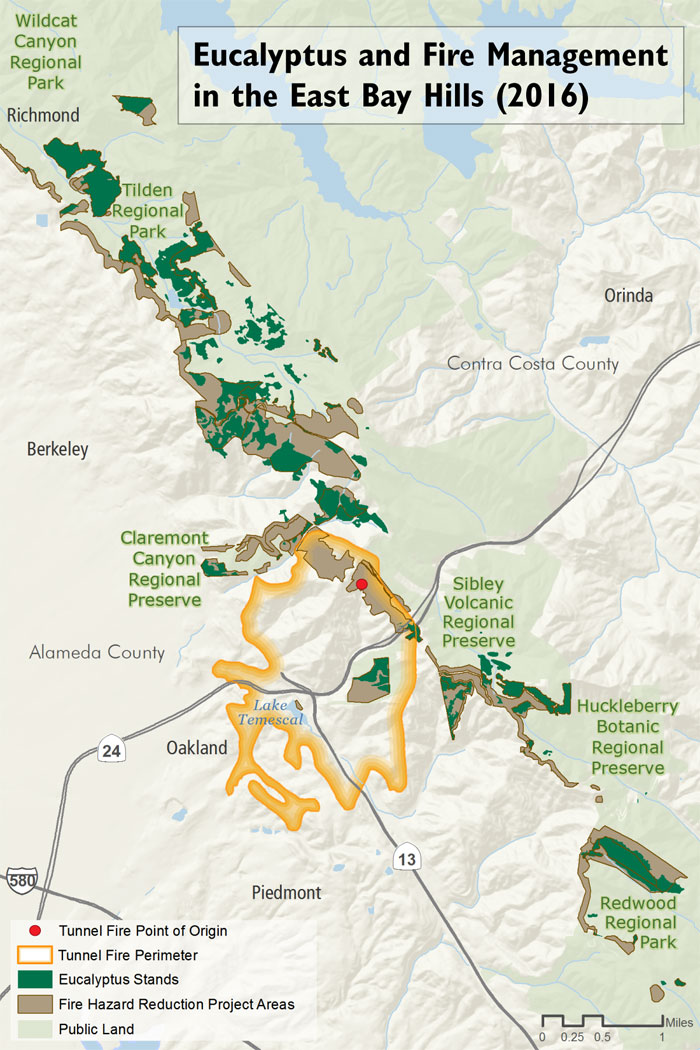
In the middle of June, I attended a protest outside the Sierra Club’s national headquarters in downtown Oakland. The 20-odd protesters—mostly white, mostly gray-haired—marched in a circle, holding up hand-lettered signs and photographs of butterflies and trees. “Two, four, six, eight,” they shouted. “Save the eucs because they’re great!”
Broadly, the protest was about the Sierra Club’s perceived hypocrisy; the environmentalist organization is also suing FEMA as a sort of countersuit to the Hills Conservation Network’s pro-euc suit. The Sierra Club suit argues that the plan should remove more nonnative trees, that leaving eucalyptus and Monterey pine standing would mean prohibitively expensive maintenance, and that removing the trees would allow native species to flourish.
It was immediately clear that the debate over the blue gum’s flammability is only one of several parallel conversations around the tree; while that is the Hills Conservation Network’s primary focus, it was not necessarily what most interested the individual protesters or their opponents. Several of the people I spoke with were worried about the use of herbicide as a way to keep the eucalyptus from resprouting. Overall, the FEMA plan calls for about 2,500 gallons of glyphosate herbicide (a possible carcinogen), or approximately 2.5 gallons per acre, to be applied to stumps. Others were concerned that the FEMA plan was cover for native species restoration advocates. Still others argued that removing any trees would be irresponsible in an age of climate change, and that native trees would not be able to take up the slack. Their concerns echoed some of those of the 13,000 people who wrote comments on the first draft of an environmental impact statement FEMA prepared ahead of the grant.
On the other side of the debate, the Bay Area’s many native plant advocates have their own long list of complaints, also mostly separate from the debate about the trees’ flammability. They call the eucs bad neighbors. Although blue gums tend not to invade new territory, they are salt-the-earth occupiers: Along with shading out other species, their leaf litter leaches chemicals that suppress growth of native plants, even after the trees are removed. “Those areas are really hard to restore,” says Lech Naumovich, a local restoration ecologist and consultant who has worked extensively in Claremont Canyon. Native plant advocates also argue that the trees are inhospitable to many native animals and generally reduce biodiversity in areas they dominate. Native plants, on the other hand, having evolved here over millennia, are better adapted to local conditions, they say.
My third visit to Signpost 29 is with Jerry Kent. A former assistant general manager for the East Bay Regional Park District, Kent is now on the board of directors at the Claremont Canyon Conservancy, which worked with UC Berkeley to convert the downhill side of the road to native vegetation. He has also independently researched the costs of eucalyptus removal and management. Kent and I walk the same path that I took with Grassetti and Maloney. By his reading, everything good about the eucalyptus across the street is matched or exceeded by the native species on this side: The native species are less flammable, use less water, collect fog, block wind, and provide more valuable habitat. Perhaps as important, Kent says, this side is cheaper. Leaving the eucalyptus as-is endangers thousands of homes and people and isn’t a viable option, he says. And in the bigger picture, simply thinning the trees, as the park district is doing on their properties, isn’t a great solution either. It would preserve a virtual monoculture and would require continual management that he believes could cost the East Bay Regional Park District alone hundreds of millions of dollars over the lifetime of the trees—and that’s if there are no fires to help the eucs regenerate. By contrast, the trees would only need to be cleared and the stumps treated with herbicide once, he says. It might look bad for a while, but with proper management nonnative grasses and brush would be replaced in a decade or two in most areas by native trees, he says. “Within a very short time, you have a self-sustaining, low-cost native forest.”
The protestors I spoke with disagree with Kent: They tended not to believe that the eucalyptus are more flammable or fire-promoting than native species, and they seemed determined to discount any evidence suggesting otherwise, arguing, as Maloney has, that whichever of the tree’s characteristics might promote fire are outweighed by its services. They point me repeatedly to both the 1992 Oakland mayor’s task force report and a 2013 report by the U.S. Forest Service’s Adaptive Management Services Enterprise Team. While the forest service report describes the blue gums as “highly flammable,” both documents advise against removing all of the trees in any area, for exactly the reasons that Maloney cites.
Still, both documents say there is a fire hazard. So do all the experts I spoke with, including the ones with no prior knowledge of the FEMA grant. The roughly two dozen Australian and American wildfire experts, eucalyptus experts, and fire ecologists I communicated with while reporting this story (the majority of them with no personal connection to the local debate) were unanimous in their verdict: Blue gum eucalyptus is especially, dangerously flammable. “Anybody who wants to encourage really flammable plants in an urban mix has to do it with their eyes open,” David Bowman told me. There is no single, knockout paper or study that shows that blue gums are drastically more dangerous fire-hazards than other local species, that’s true, but that’s probably too much to ask anyway. Ross Bradstock, a wildfire expert at the University of Wollongong, says that while being able to empirically compare the flammability of different trees would be useful, it’s not currently possible. Leaves or other components, meanwhile, can tell you only so much about the whole, and individual trees only so much about the forest. “We’re in our infancy in understanding how flammability can be practically measured and scaled up,” he says.
“We’re trying to change fire behavior, to make it easier to put the fire out, to give people more time to evacuate.”
-Brad Gallup
Now imagine a fire. Not just any fire, but the fire, the fire that all this is about. It’s late September, in a eucalyptus grove on the ridgeline above the UC Berkeley campus. The grove is one of those that were logged off after the 1972 freeze, and the trees grew back just a few feet apart, hung with bark and knee-deep in fallen leaves, bark, and twigs. For most of the year, these trees would collect fog and slow the breeze, and they might indeed make a fire less likely, Scott Stephens says. But not today. The summer fogs have faded, and it’s been unseasonably hot for a week. Relative humidity is in the low teens, and any moisture hidden in the debris below the trees has long wicked away. A strong wind begins blowing over the hills from the east. And then somehow—maybe a spark from a car, maybe a tossed cigarette—the whole dry, airy mess catches fire.
Now the flames on the ground are 30 feet high and even higher off the boughs, roaring like a jet engine. At the fire’s edges, trees appear to explode as the volatile oils in their leaves reach their boiling point and vaporize. The heat of the fire forms a convection column, with 60-mile-per-hour winds that rip burning strips of bark from the trees and toss them upward. This is another of blue gums’ talents—its bark makes ideal braziers. Tucked away inside a rolled-up strip of bark, a fire might live for close to an hour and fly 20 miles. Native species and grasses produce sparks and firebrands too, Stephens says, but not of the same quantity and quality as eucalyptus. The shower of firebrands tossed from the ridgeline by the 100-foot-tall trees foils any attempt to create a firebreak.
At this point, there’s nothing anyone can do to stop the fire, Brad Gallup says. “Nature’s going to put that out.” We’re on a ridgeline above UC Berkeley, across the street from the grove in question. I met him that morning at the park district fire station at the edge of Tilden Regional Park, and we’ve driven together into the park, stopping first at this overlook along Grizzly Peak Boulevard. Gallup, who has gray hair and thin-frame glasses, is dressed head-to-toe in navy and wears black leather fire boots. He is persistently neutral: “Everybody’s right, everybody’s wrong,” he says at one point. It is true, he says, that—as Maloney argues—a fire would spread through the grass covering the hillside on this side of the road much faster than through the eucalyptus opposite. It might indeed get away, or catch houses on fire. But even under the worst conditions, there is the possibility of containing a grass fire, he says. That’s the idea in thinning the eucalyptus—not to prevent fire, but merely to create the possibility of keeping it from growing out of control even in those rare instances when conditions are at their worst. “We’re trying to change fire behavior,” he says, “to make it easier to put the fire out, to give people more time to evacuate.”
We drive along the ridgeline and re-enter the park, and into what looks and feels like a vast eucalyptus forest. Gallup parks his truck and we get out to walk down the fire trail. We pass a man in an excavator stacking eucalyptus logs. The air begins to smell of fresh sawdust. And then from somewhere down in the woods there is the sound of a saw.
The East Bay Regional Park District is taking something of a middle approach to fire prevention in the eucalyptus groves it manages, thinning the trees rather than clearing them outright. (This is the approach that Jerry Kent predicts will cost the most, and native plant advocates say will result in a monoculture, though it is acceptable to the Hills Conservation Network.) The goal, Gallup says, is to get to less than 100 trees per acre, down from as many as 1,700 per acre in some areas. After arborists thin the smaller trees, youth crews will clean up debris and hanging bark. When the project is finished, he says, only the bigger trees will be left, with a wide gap between the forest floor and its canopy. This “shaded fuel-break,” as he calls it, should help slow down fires.
We turn a corner and stop between a feller buncher (which both fells trees and gathers them into bunches) and a chipper. The seven-boled tree is on the uphill side of the trail. From the gully below comes the whine of the saw; then it stops and a young eucalyptus topples over with a drawn-out crash. A man in a hard hat and orange vest emerges from the bushes, then cuts through another tree. The forest between us and him is already mostly thinned. The trees that remain standing are big and widely spaced. Smaller trees lie between, yet to be hauled off or chipped. Bark still hangs from trunks, awaiting the youth crews. It’s still messy, a sculpture only half done.
This is Gallup’s favorite part of the job, he says—choosing which trees to remove, which trees to keep. There is an art to it, he says. “If the plan says ‘thin eucalyptus,’ then that’s what I have to do,” he says. “But I can use my professional judgment. There’s no exact number.” When he starts a thinning project, he walks the grove and imagines how it might look without this or that tree, how the canopy would look, how it would look in a decade, in three decades. And he imagines it catching fire.
Editor’s note: In late September, FEMA rescinded its fire mitigation grants to UC Berkeley and the City of Oakland, covering the 350 most contentious acres. It did not offer an explanation. A UC press release stated that the fire hazard mitigation work in Strawberry and Claremont canyons “will be delayed for an indefinite period.”

